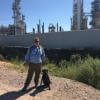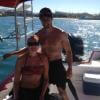New Paper: Drones and Bornean Orangutan Distribution
 Sol Milne
Sol Milne
12 February 2021 12:00am
WildTrack Women in Science Day, 11 February 2021
11 February 2021 1:48pm
Consulting Opportunity: Product Manager - Supply Chain Traceability
11 February 2021 4:34am
News: FieldKit Presales and WSJ Feature
 FieldKit
FieldKit
11 February 2021 12:00am
Module 4: Tying It All Together
 Akiba
Akiba
11 February 2021 12:00am
Who’s who - Introduce yourself!
7 December 2018 4:42pm
9 January 2020 7:41pm
Hi all! I hope everyon had a restful break. We have a couple new members to the group! @dalenerusso and @ediminin can you please introduce yourselves here?
9 February 2021 1:57am
Hello All,
My name is Karima Cherif and I work for WildAid Marine and our focus is to end wildlife trafficking in our lifetime. I specialize in marine electronics and work in Gabon, Galapagos, Tanzania, and the Bahamas. In Gabon, we have many small scale fishing canoes that transport illegal bush meat such as pangolin and shark fin. Especially, with COVID the trafficking is increasing as people are becoming more despair to feed their families and cover their basic expenses. I append an article from NBC that discussing a new app that we developed in 2020 called O-Fish (Officer's Fisheries Information Sharing Hub). It is free and we invite MPA managers and agencies to try it.
Intro to Embedded Machine Learning on Coursera
 Edge Impulse
Edge Impulse
9 February 2021 12:00am
How do I strategically allocate drones for conservation?
8 February 2021 12:00am
Funding Opportunities: Panthera Grants and Fellowships
 Panthera
Panthera
8 February 2021 12:00am
Rogue Detection Dogs Webinar - Free
7 February 2021 5:25pm
Tech Tutors: How do How do I launch machine learning projects using MLOps?
3 February 2021 12:08pm
5 February 2021 7:16pm
Dan's comments about the need for technologists and conservationists to manage and share (properly annotated) data struck a chord with me, it was right at the end of the presentation.
I fired off a point into the chat "could your old background data be my background data?" or something similar, and it got me thinking...
(Firstly, sorry for clouding this issue with my simultaneous "Ian Tuna" joke)
In the context of using AI as described in EdgeImpulse example, lets say - audio.
Lets say Group A are trying to detect the roar of lions, and Group B are trying to detect the grunt of wild pigs, and lets imagine that is in roughly the same area of Africa. I mean they could both send out teams to capture the sound of their target animal, and the sound of NOT their target animal, e.g everything else.
Well if "serengetti sounds" was a known audio track, then all you need is the unique sound of the beast in question, am I right?
WildLogger Add-On Board Requests
4 February 2021 2:10pm
5 February 2021 6:28am
Hi Akiba,
Yes, the TSL2591 has an interrupt pin and there are also a couple of example applications in the Adafruit and TSL2591MI libraries. I am doing tests making the connections with Dupont cables in the I2C connector of the Wildlogger, and for the interruption I will use the corresponding pin of the PIR connector
The connections do not concern me since, once the prototype has been tested and defined, my idea would be to make the maximum of welded connections to avoid failures
I'm still in the design phase, I already have the hardware quite defined, and now I have to enter with the most difficult part, the software, which for me is where I have the most difficulty
I have been gathering the elements to prepare the cake, and now is the time to enter the kitchen, I will not deny that I am excited and terrified at the same time
I'm already telling you ...
Regards !
5 February 2021 9:05am
Hi JAL.
Excellent! I'm glad you've already started on it and Dupont wires should be no problem. Let us know how it goes and if you have software issues, feel free to post them in this forum. Good luck and please take pictures of the modified Wildlogger and also the deployment. It sounds like an amazing application!
Akiba
5 February 2021 12:35pm
I appreciate your encouragement !
Don't hesitate that I will keep you informed of the progress that I am making
Happy weekend !
Seeking interviewees - AI in Conservation & nonprofits
9 December 2020 6:20am
16 January 2021 7:13am
Hi @Alex.L , I would suggest the same as for @mattzig at https://www.wildlabs.net/community/thread/1046#post-4348 :
I could try to connect you with some of the people and orgs we have worked with. If you go through https://www.vizzuality.com/project/ and identify the projects you would like to be look into, I can then try to connect you with the best person for each project.
And I would be very interested in learning more about your research group's work, besides your current research question, if possible!
Happy New Year! Luisa
28 January 2021 6:40am
HI Luisa,
Thank you so much for your help! I will definitely take a look at your organisation project list. I will be messaging you directly shortly. I would be glad to discuss my research group if it interest you.
Best,
Alex
4 February 2021 3:48pm
Hi Alex, that sounds great! Feel free to email me at [email protected], that may be simpler.
Carly's video blog journey
22 January 2021 9:50pm
23 January 2021 6:16am
Hi Carly.
The videos are wonderful! They're hilarious and also let me know areas we can improve on :)
Akiba
4 February 2021 2:42pm
Round 2 vlog video is up!
Module 3.3: Measuring Battery Status
21 January 2021 11:54am
4 February 2021 5:00am
Hi JAL.
I'm glad you're enjoying the WildLogger! What you're doing fits exactly the purpose of this course. It's demystifying the art of customizing research equipment. For the WildLogger, if you will be using it to collect scientific grade data, I recommend to upgrade the board to use an external analog reference. There's already a footprint and we will add that to the shop this week. It's a cheap part but will stabilize the ADC reference vs temperature and also has 0.1% accuracy so that you will get more accurate ADC readings across temperature. I think we're targeting $1 for that part so it's a cheap upgrade. Currently the power supply is used as the ADC reference to keep costs down which is accurate to around +/-1.5%.
In regards to the power supply and power requirements, the battery input needs to have a voltage of between 3.6V and 5.0V. A single cell lithium-ion or lithium-ion-polymer battery would be fine at a nominal voltage of 3.6V and full voltage of 4.2V.
in sleep mode with an average SD card that implements power savings modes (like SanDisk), it consumes around 0.8 mA. If you're calculating battery life, you can use that as a theoretical maximum battery life, ie: if you use a 2000 mAHr battery, you would get 2500 hour battery life or ~100 days max. We usually divide by 2 or 3 to get a realistic battery life.
We'll also be making some bonus sensors and training materials specifically for the WildLogger so people can extend it to different applications. We'll announce that soon, likely once we're caught up on the video creation. Also do let us know if you have requests for sensors, displays, etc.
Hope that helps and let me know if you have any other questions.
Akiba
4 February 2021 6:34am
Hi Akiba,
Oh, your answer is great!
My idea is to build a DL that allows,
- Light registration, with time stamp, when it exceeds a certain threshold (To control the human presence in the cave) The card only has to record when this threshold is exceeded to save energy
- Periodic record of temperature and humidity
- Data recording on SD
- Autonomy of at least 4 months
I have tried some sensors and I think I will use the TSL2591 because it has a very low detection threshold (0.18 uLux) and has an interrupt pin. I've already been testing some sample libraries, and I think it would be ideal
For temperature and humidity I am hesitating between using the DHT11 or the BME280
Perfect the external reference of the ADC if it serves to have more accurate readings
My idea is to use a power bank with 3 or 4 18650 Lipo batteries and built-in BCP, and to be able to disconnect the device when it detects that the power supply is less than 3.2V
Is the Sandisk card you mention a normal one, or of an industrial type like the one you presented in the corresponding module?
My best wishes,
4 February 2021 1:13pm
Oh that sounds like a fascinating application. I've actually just started a thread for Wildlogger add-on board requests. The TSL25911 sounds do-able and also it looks like one useful thing would be to put together some adapter cables to other popular modular systems like the Adafruit Stemma and Seeed Grove. Let's discuss this in the other thread.
Module 3.2b Command Temp and Humidity
3 February 2021 5:34am
3 February 2021 6:44am
Hey,
In the cmdTemperature and cmdHumidity functions, there's full stops between void and cmdTemperature and cmdHumidity. Can you try removing them and see if that works?
Cheers
Jacinta
3 February 2021 10:18am
Omg thank you. Just flew over my head
4 February 2021 12:21am
No probs. We've all been there (and will be there again)!
Glad it's working
cheers
Jacinta
Poison Detection Dogs for Wolf Conservation
3 February 2021 12:47pm
3 February 2021 5:51pm
I have seen posts on social media about poison detection dogs and I THINK I am connected to one of the teams. I will check.
Paul
Documentary Series : scientific and technologic innovations to protect endangered animal species around the world
3 February 2021 5:11pm
Research paper: Training and olfactory generalization in conservation detection dogs for an endangered stonefly species
2 February 2021 4:20pm
Module 3.4: Real Time Clock
21 January 2021 12:28pm
2 February 2021 2:30am
Hi JAL.
For Module 3.4 - Lab 4a, the time will be hard coded into the sketch and then it will just print that time out. It's just to demonstrate how you would set it and how you would print it out. Every time you reset the board, the same time is reprogrammed into the real time clock so it will never advance.
Where you will see the actual real time clock behavior is in Module 3.4 - Lab 4b where you set the clock from the command line and can read it from the command line. Since it won't be hard coded but rather set at run-time, and then independently read out, you should see the clock advance. Also you should only need to set the clock once as long as the backup battery holds up (should be good for a few months to years).
Please try lab 4b and check if the clock can advance. You should see the seconds incrementing at least.
Akiba
2 February 2021 11:57am
Hi Akiba!
Now it's okay, and the clock is ticking!
Now I understand the errors I made, I had used the example of the Rtc_Pcf8563 "Setclock" library that contains in the Setup an "rtc.initclock" statement, with which every time you restart the program the clock starts counting from the starting point of departure.
Your first example did not set the clock either, and it only served to enter a time and print it later.
I had also tried to use the Rtc by Makuna library to automatically synchronize the time of the PC with that of the RTC, but I got a time loss error, as if, for some reason, the RTC did not retain the time. It is true that this library is designed for other RTC models of the DS **** series, and surely the error comes for that reason
Do you know if there is a library to fulfill this function with your RTC?
Thank you !!
2 February 2021 3:33pm
You'll need to write a software application that would communicate from the PC to the board via serial. Within that software application, you could send the time and date to the Wildlogger application, ie: through the command line interface. This would automate the synchronization.
Akiba
Using AIS Data to Investigate the World’s Fishing Ports
 Max Schofield
Max Schofield
2 February 2021 12:00am
How do I get started with LoRa? Connectivity in conservation
1 February 2021 12:00am
Career Paths and Conservation Games with Diogo Veríssimo
 Diogo Veríssimo
Diogo Veríssimo
1 February 2021 12:00am
Open Source Camera Trap
24 January 2021 7:22pm
25 January 2021 4:41am
Akiba I have used ubiquiti loco m5 to broadcast internet with great success when I was setting up internet for a park for a 10k run I was able to get atleast a mile with no issues with internet
not discorcuaged just looking to piggy back off of a local wifi and be able to connect to a diy camera trap and be able to either do live video feed or capture a pic and then with a program I create send it to email or txt message
the place I am looking at I can get almost a mile in distance but the problem is the power it would have to be some kind of solar power don't want to have to change batteries ever other day
31 January 2021 10:06pm
Something I'm working on that might work well for you and is super affordable at about $30 per camera.
ESP32-cam (not super high quality photos though) with a motion sensor and it sends the photos to a PI Zero W that can be accesses at any time via wifi. I'm using the TPlink portable but have found that WemosD1 boards and upgrading the firmware to be able to do wifi repeaters works well.
Here's the camera I'm using:
https://starairvision.com/esp32-cam-motion-camera-with-date-and-time/
I'll make a post on here when the full project is built and I've tested the range. The repeaters use something called mesh networking. You can have a number of them in a row to get the camera out into the forest. Or if you have lign of sight you can use a signal booster and or a directional antenna.
31 January 2021 11:39pm
Thanks Ryan would like to hear more about this, the project look awesome what distance are you getting from your wifi router
Audiomoth and Natterjack Monitoring (UK)
23 December 2020 8:16pm
31 January 2021 2:09pm
Hi Sarah, I'm curently working on the sound identification of native and introduced frogs in the UK. I need another season of recordings, and a lot more recordings of Natterjack's, but my aim is to build these into the BTO Acoustic Pipeline hopefully later this year - alongside bats, small mammals, bush-crickets etc to also identify these automatically when they are recorded as 'by-catch.' https://www.bto.org/pipeline.
31 January 2021 3:26pm
Hi Stuart, What sample rate do you think you could go down to? We're interested in a low-power AudioMoth firmware version for this application. Alex
31 January 2021 4:38pm
Hi Alex, I'm not sure what problems there could be with aliasiing and harmonics using a low sample rate, and may depend I guess on how the recordings are processed later on, but I've enclosed a spectrogram of a typical recording below, and can send you some example recordings if useful. Perhaps to use a sample rate of about 10 kHz.., but it's not something that I think about - I always use an excessive sample rate (24 kHz for anurans).

BTO Acoustic Pipeline - is launched!
31 January 2021 1:37pm
Tech Tutors: How do I start a Tech4Wildlife collaboration?
28 January 2021 12:55pm
28 January 2021 6:22pm
One barrier that was discussed in the presentation was the "risk" or uncertainty of a payoff when talking to potential funders. It seems to me that the "risk" factor of collaborations like this, for funders, would be analogous to the investment and payoff when developing a genomics program. Relative to traditional field research, it takes a much greater investment in time, with different expertise, to create a reference genome for a species of interest and then pull SNPs, etc. Nevertheless, funders seem to recognize the potential for genomic research and genomic tools. Do you think that greater openness to “risk” in conservation genomics results from closer intellectual proximity (i.e., molecular biology vs organismal biology), or to conservation genomics being a more mature field (i.e., more examples of success), or to other factors? If intellectual proximity is a key factor, then conservation tech collaborations will continue to face this barrier, but if lack of successful examples are a key factor, then perhaps this barrier will become less of an issue for conservation tech in the future. Thoughts?
30 January 2021 2:26am
Hi. Just watched the Youtube version (I'm in the unable to watch live hemisphere) and wanted to say that was a great talk. I wish it could have gone for another hour. I liked hearing about the issues and concerns from Melanie on the biology/ecology side. Also could totally relate to what Ed was talking about from the tech side about how it's difficult to have long term collaborations since there isn't really a conservation technology career path at the moment.
I think one of the things we're trying to do with courses like Build Your Own Datalogger is to get people involved in wildlife/conservation side more comfortable with the tech. The goal is to hopefully build a shared repository of technical knowledge that people in the wildlife community can contribute to and benefit from.
Akiba
University & Grad School Resources
5 November 2020 11:04pm
12 November 2020 11:01pm
Hi all,
Dropping in with another great program! Many of you have probably heard of this one already: it's the Smithsonian-Mason School of Conservation! They have courses and training options for all education stages, including for high school students who are thinking about following a conservation career path.
The graduate and professional short courses also have a strong conservation tech focus, with training options in GIS, camera trapping, and statistics, specifically. Definitely worth having a look! You can find their courses here.
-Ellie
18 November 2020 8:20pm
Hi again,
WILDLABS member Meredith Palmer shared this great course module for undergrads, based around Snapshot Serengeti camera trap data! This materials are useful for professors who are looking for resources for online biology courses, but the resources may also be useful and interesting for those of you who are exploring conservation tech career options and want to learn more about camera trap studies.
-EllieWe've been hard at work to create distance-learning material based on our #citizenscience #cameratrap projects to teach concepts in #ecology and #conservation. Excited to announce that our 5-week online undergrad module is now available on @CourseSource! https://t.co/5k1dQ8WVJe pic.twitter.com/Huf1MB9ZDG
— Meredith S. Palmer, Ph.D. (@songofdodo) November 18, 2020
29 January 2021 11:17pm
Those of you who are interested in bioacoustics will want to check out this Master's course!
Looking for a master degree in #bioacoustics? Already doing your PhD & wanting to spend 4 months studying #bioacoustics? Look at MoBi, a new Master's course in Bioacoustics, taught in English by over 30 expert tutors from around the world. https://t.co/SgoFRQGpZA
— Nicolas Mathevon (@MathevonNicolas) January 29, 2021
Please RT!
WWF Conservation Technology Series: Drones in Conservation
19 November 2020 9:11am
24 November 2020 8:33am
Hi Julie,
yes authorizations are needed for drones and these are particularly difficult in many countries and are specific to the weight/size of the drone. Look at our report because the difference with a drone from an (untethered) balloon is the the presence of active collision avoidance, manueverability, size/weight and how far it flies (i.e. if it is beyond line of sight it is a different permit).
4 December 2020 12:15pm
This looks like a great resource, thanks!
29 January 2021 7:17pm
Hello Aurelie,
Thank you for sharing this info. I just downloaded the brochure and I am sure I will find it very useful. I have senseFly's eBee Classic, with RGB, multispectral and thermal cameras, and look for cases of using those in nature/biodiversity monitoring/management. I guess the brochure will include some cases. Thanks for sharing.
kind regards, Giorgi (from Georgia)
EarthHz tool
29 January 2021 3:39pm





















5 September 2019 7:54pm
Welcome to the group, @divyar ! Can you please tell us a little more about yourself and your interests in this thread? Thanks!